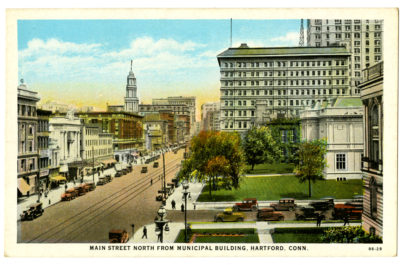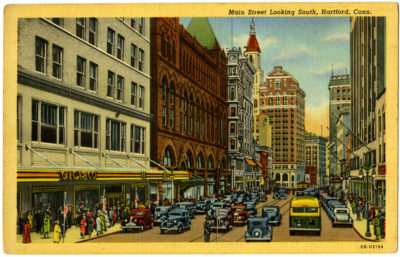Hartford’s hidden histories
20 March 2019 – Kristina Oschmann
Hartford series 2019, American Revolution, community history, sense of place, race, slavery, Immigration, American Civil War, 2019 annual meeting

Main Street looking north from the Municipal Building, Hartford, Connecticut, circa 1930. Image credit: Connecticut Historical Society
Editor’s note: This is the third in a series of pieces focused on Hartford and its regional identity which will be posted before and during the NCPH Annual Meeting in Hartford, Connecticut in March.
Growing up in eastern Connecticut, my thoughts of Hartford were a mix of positives and negatives. I knew that the city was the insurance capital of the world, that it was a longer drive and a busier place than my hometown, that it had museums I wanted to visit, and that you would occasionally hear about gun violence and crime in the news. As I started working in Hartford while in graduate school, my opinions of the city changed. I became more involved in learning about what was going on in the community and I visited the sites that tell the city’s history. I sought out some of Hartford’s hidden stories and in so doing, became aware of the diversity that exists in Connecticut’s capital. Now, when I think of Hartford I think of the city’s unique history and landmarks that make it a vibrant place.
The city’s newest slogan, “Hartford Has It,” was developed around the idea of motivating people in and around Hartford to invest in the city. It hopes to instill a sense of optimism and pride. No longer only a waypoint between Boston and New York, the city began to forge its own path. In 1635, Thomas Hooker led a group of settlers to the banks of the Connecticut River, originally home to several tribes that were part of the Algonquian Confederation. You might have heard about our legendary Charter Oak Tree, which kept our royal charter safely hidden inside of it when King James II demanded its return. The tree was toppled in 1856 in a storm, and it became a symbol of Hartford and Connecticut. Yes, we have built up an entire mythology around a no longer standing oak tree, including thousands of relics. We’ll let you decide if they are all “real” pieces of the Charter Oak.
During the Revolutionary War, Connecticut adopted the nickname “The Provision State,” supplying goods to the Continental Army. Later, manufacturing for World War I and World War II continued to fill that promise. Industry has long been important in Hartford and Connecticut—farms, mills, and factories have dotted the landscape for centuries. I’ve lived in a mill town most of my life, and the textile mills continue to define its sense of place and bring the community together as history, art and culture combine and flourish. Look to Hartford’s skyline for the blue onion dome and you will see a landmark that represents Samuel Colt and the power of the city’s past as an industrial center, or maybe a symbol to the nefarious role guns have played in our history.
Hartford has always attracted a diverse group of people because of its economic promise and opportunity. Northern Europeans arrived in the nineteenth century, and Southern and Eastern Europeans in the twentieth. By World War I, European immigration slowed significantly as many returned to their home countries. An influx of African Americans from the south, part of the Great Migration, filled this void as they migrated to northern cities. Today, Connecticut’s diversity has expanded yet again, with the arrival of the Latino population. Frog Hollow is just one example of a flourishing ethnic community in the capital city.

Main Street looking south, Hartford, Connecticut, circa 1930. Image credit: Connecticut Historical Society
Main Street Hartford and the immediate area around it houses a variety of intriguing landmarks and modern conveniences. If you are looking to take a stroll, start on the far end of Main Street. Here you will find the historic G. Fox department store building, which now houses Capitol Community College in the 1918 section of the building. As part of Hartford’s revitalization, the building received a full renovation, with some of the key art deco attributes preserved. Many locals know G. Fox as a place where Hartford’s residents worked and shopped, but did you know that Beatrice Fox Auerbach, the department store’s President, entertained Eleanor Roosevelt in her tenth- floor office? Or that the store was a leader in employing minorities for sales and supervisory positions during the 1950s and 1960s, and offered women opportunities to move up in management, in a time where men held most of the executive positions? Although the G. Fox site has such a rich and varied history, methods to display this story to the public on Main Street have not been utilized to their full extent. The Connecticut Historical Society hosts G. Fox behind-the-scenes tours several times throughout the year, giving attention to this period of history and the Fox’s accomplishments, but these tours are located at the museum—not the department store site.
In contrast to this, Connecticut’s Old State House (OSH), just off of Main Street on the opposite end, is an example of active interpretation. At the OSH, visitors learn how democracy was born in Connecticut and the people behind it. They aim to offer an educational and inspiring visitor environment where ideas are on display—ideas from the past and today—allowing for discussion and debate. The site also has more eccentric elements—like their two-headed calf. These elements engage visitors behind a specific learning outcome, allowing patrons to come away with something that might influence their lives.
Also along Main Street, the Civil War can be seen in the horizon of Bushnell Park, with the Soldiers and Sailors Monument in Bushnell Park. Locate a bronze plaque under the image of a freed slave, honoring the African American residents of Hartford who fought for the Union. Interested in the history of homelessness? Visit the Butler-McCook House and Garden and ask about Rev. John James McCook and his study. Stop by the Faith Congregational Church, formerly the Talcott Street Church, to learn about its beginnings as a safe haven to speak out and organize around American slavery, and later about faith-based justice.
Interpretation is key to understanding a location, and while Main Street boasts some exciting places, interpretation is lacking. Both passive and active interpretation could be employed to engage the area. Creating interpretive signage is a start to delivering the information to the public though it has limitations, such as the space to tell more than one side of the story. In the future, more active interpretive supplements could be utilized. Attending an existing themed tour, such as Steve Thornton’s Shoeleather History Project, or the Black Experience tours featuring the Harriet Beecher Stowe Center, the Connecticut Historical Society, and the Amistad Center, are intriguing ways to find out about some of the city’s most exciting stories.
Unless you are searching for the hidden stories of Hartford, you are missing out on its narrative. What will you stumble upon in your time in the capital? Tweet @KristinaO112 with your experiences!
~Kristina Oschmann is a graduate of Central Connecticut State University’s public history M.A. program, and currently works in the research center at the Connecticut Historical Society. Her research interests include material culture, World War I, and Irish history. The views and opinions expressed in this post are those of the author and do not necessarily reflect the official policy or position of any other agency, organization, employer or company.




Excellent work. A beautiful description of a vibrant city.
Very interesting read, we do have an abundance of great history in this state, and who better to take us through it than Kristina from a younger generation’s mind at that. Great Job!
Greetings Ms. Oschmann, Thank you so very much for your informative and interesting writings. This information is very important to our city history. I teach and lecture about Hartford history (both free !) of 1600s, 1700s, 1800s, 1900s. I think it is important for our residents and others to know the history and knowledge of our city, its people and places, that made achievements and contributions. I teach information that other historians do not. ( I give the dirt and other interesting details. There are many fun stories, too !) ) History is bad and good, but it is still history. I teach and lecture on a volunteer basis as I am happy to help people to learn. Also, hopefully, it will encourage them to learn more and help others to do so, too. Best wishes on your history stories endeavors. If you would like to learn more, please contact me. Best regards, Wendy Pawlak Hartford historian and education advocate ( text me ! 860+256-7869 )
I live at 257 Fairfield Ave in Hartford. I have been told that the house next door (255?) was the first Jewish Orpanage in the city c.1912. Is this correct?